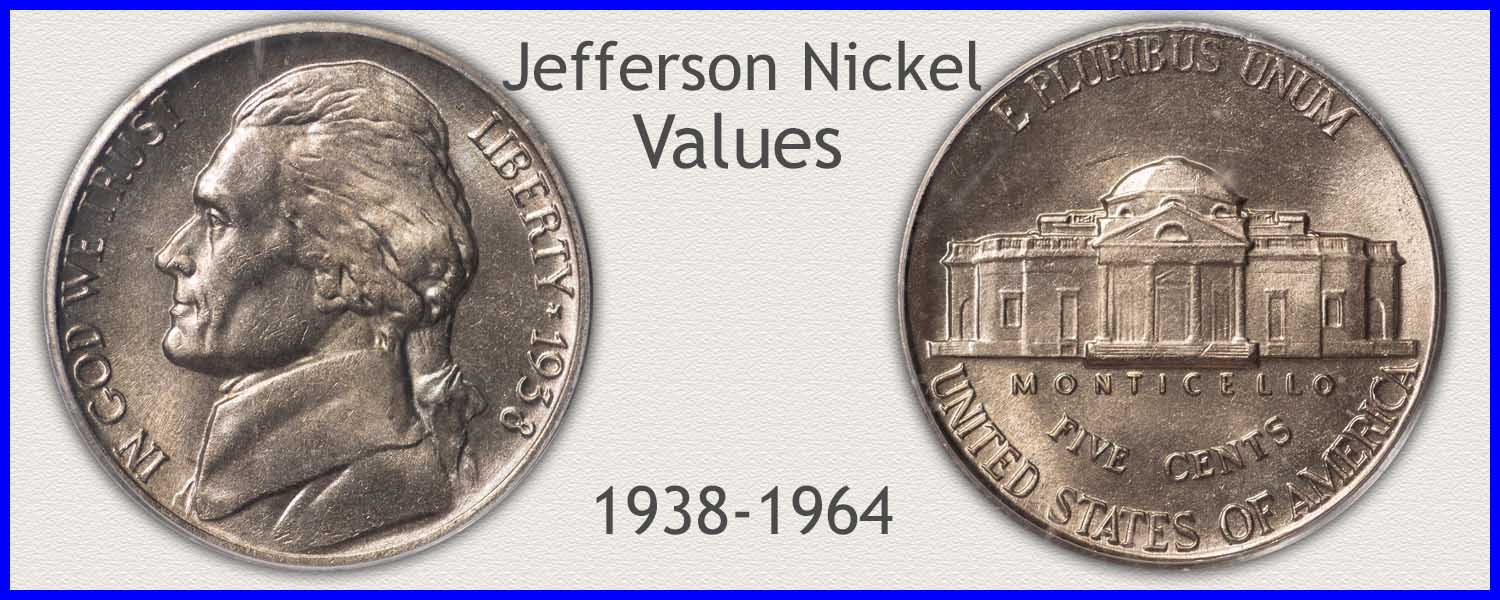Coin Values Moving with Precious Metals: Up-Dated 12/29/2025: Gold $4449 | Silver $75.46
1963 Nickel Value
Using a few steps identifies on the chart your 1963 nickel value. Today's Jefferson nickel market favors examples in the Mint State condition.
Steps are followed to compare your coin to images representing mints and condition helping identify the coins with premium values.
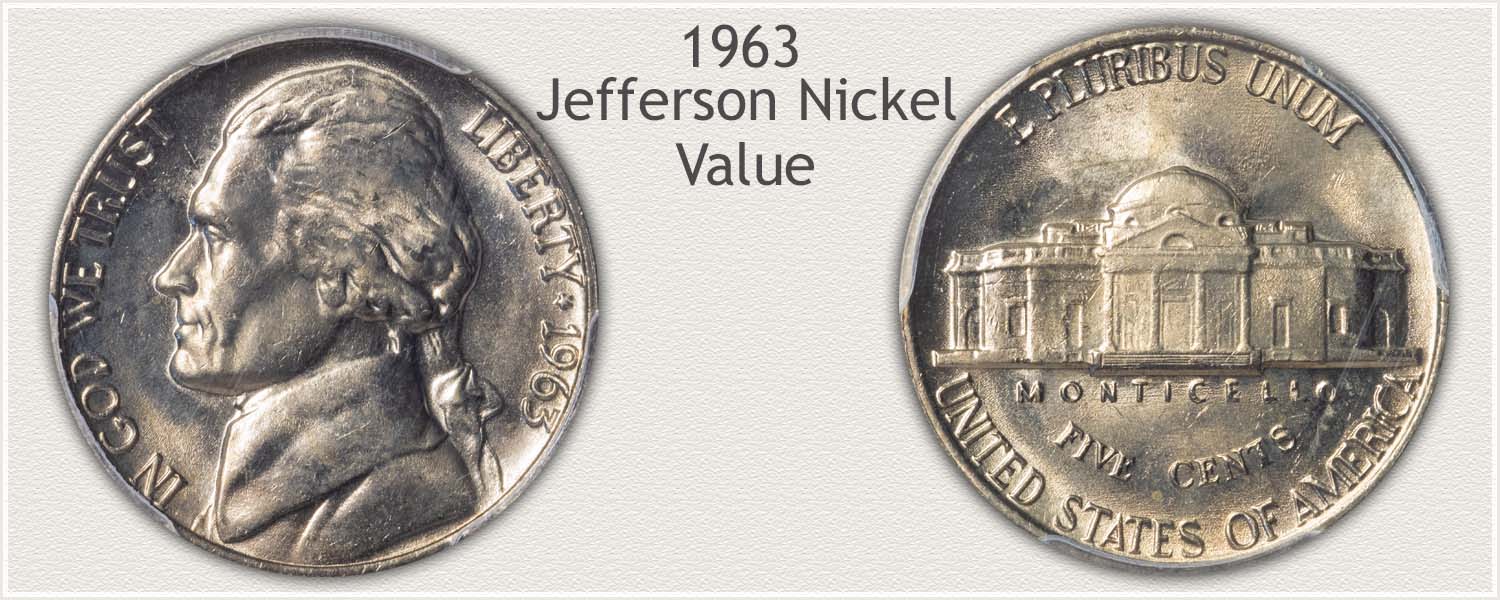
Steps Leading to Value:
- Step 1: Date and Mintmark Variety - All date and mint varieties are identified as an important part of the value process.
- Step 2: Grading Condition - The biggest factor to premium status is the condition of Jefferson nickels. Match your coin to the grading images to judge condition.
- Step 3: Special Qualities - A close look at subtle qualities is done to spot the exceptional coin.
| 1963 Jefferson Nickel Value | ||||
|---|---|---|---|---|
| Condition of Coin | ||||
| Date | Good | Fine | Extremely Fine | Mint State |
| 1963 Jefferson Nickel Value Up-Dated | 2026 | |||
| 1963 | $0.05 | $0.05 | $0.05 | $0.47 |
| 1963 D | $0.05 | $0.05 | $0.05 | $0.47 |
Following the steps below begins the judgement of your coin and understanding of appeal to collectors. Assembling collections of vintage Jefferson nickels forms the base to demand and why elusive coins rise in value.
Rare date and mint combinations are a small factor to value of a 1963 nickel, many remain today. It is the condition of the coin with the potential to set it apart from others and create demand from collectors. Proceed through the steps to accurately determine how much it is worth.
Step 1: | Date and Mintmark Variety Identified
Two Varieties of 1963 Jefferson Nickel to Recognize
Jefferson nickels are typically assembled into sets with examples representing each date and mint combination. In 1963 Philadelphia and the Denver mints struck nickels. This remains important to identify the mint striking a 1963 nickel.
Ample quantities remain of the two varieties with little premium difference. 1963 is considered by collectors as an abundant year with many remaining today. Condition is the deciding factor to premium value.
1963-D Jefferson Nickel
"D" Mintmark on Reverse: Denver Mint Struck the Coin
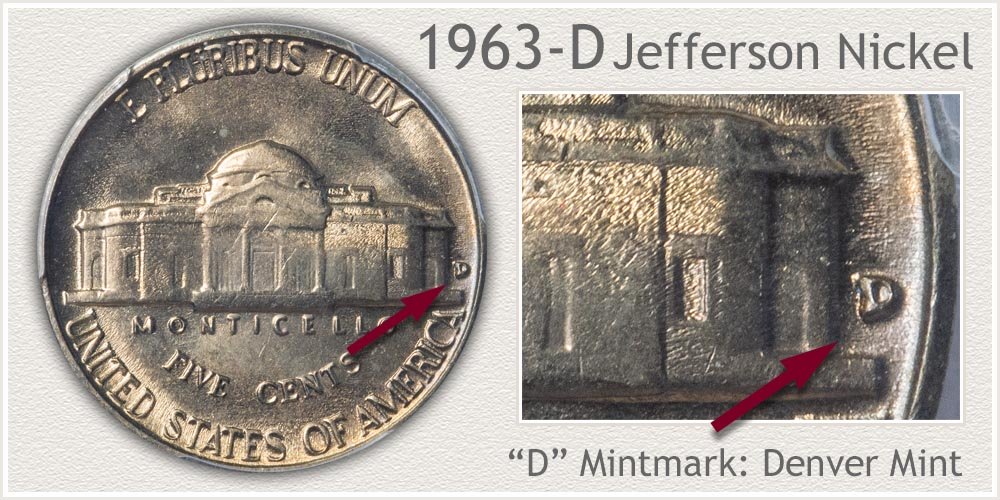
Continuing a string of ever-increasing production years, Denver struck 276,829,460 "D" mintmark nickels in 1963. Supplies to collectors of the 1963-D mint variety are abundant. A typical condition coin shows moderate wear.
Denver placed a "D" mintmark on its coinage in the 1960's. To the right of Monticello on the reverse, a "D" mark next to the rim is the Denver mint variety.
1963 Jefferson Nickel
No Mintmark on Reverse: Philadelphia Mint Struck the Coin
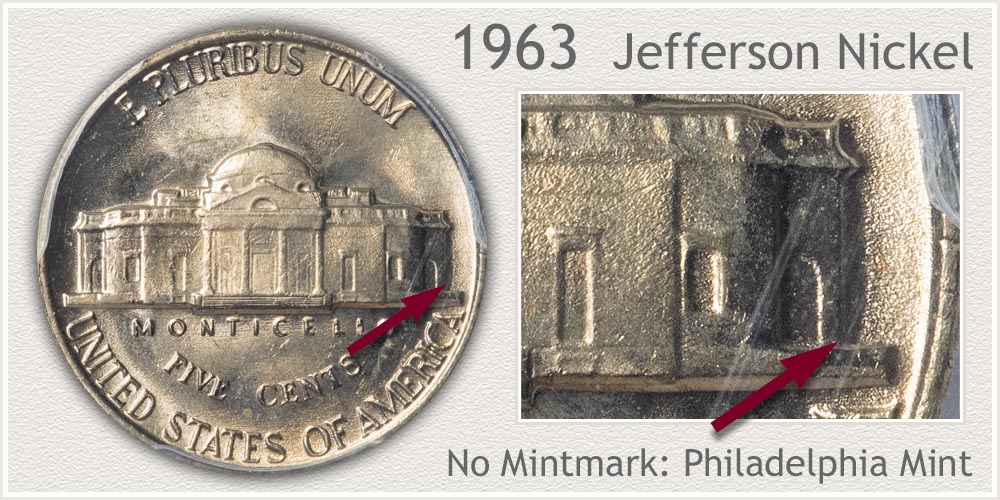
Very large numbers of 1963 nickels were produced by the Philadelphia mint, over 175 million. Although these were released into circulation and most became worn and lower condition, ample quantities of nicer coins remain today. With a large number available, collectors choose the higher condition pieces to add to collections.
No mintmark was used by the Philadelphia mint on 1963 nickels. On the reverse, to the right of Monticello, the space between the rim and building is empty. No mintmark confirms Philadelphia struck the coin.
Step 2: | Judge Condition to Identify Grade and Collectible Quality
Quality Determines 1963 Jefferson Nickel Value
Grading is a process of inspecting a coin and determine its level of preservation. 1963 nickels fall into two major grades and value categories. Collectible value pieces are Mint State coins and circulated - worn coins fall below collectible condition. Images of the different conditions are used to compare your coin to determine grade.
Mint State Grade
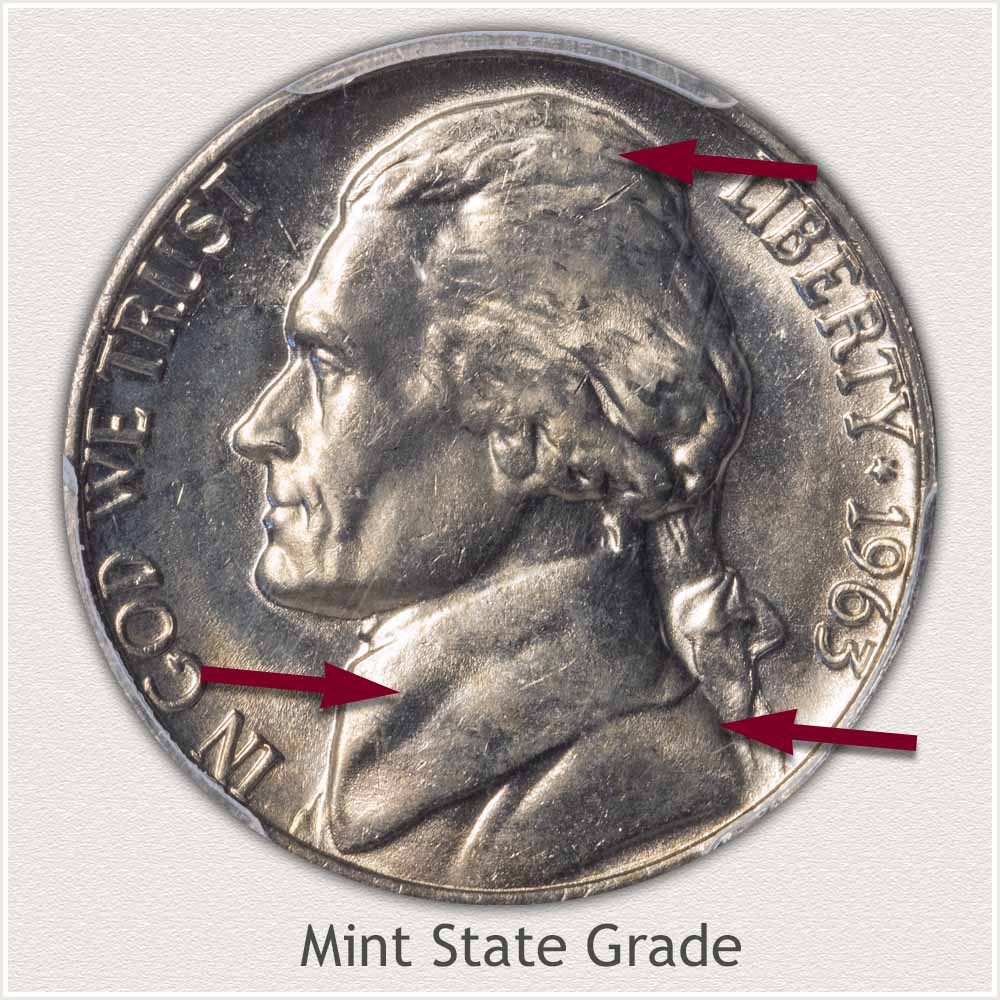
Mint State: A newly minted coin represents an nickel with full details at the time of striking and also displays luster - the shine - over the entire surface. This top condition coin is without wear to the surface, the definition of Mint State. Inspecting and grading key points on the coin confirms no wear.
High areas prone to first wear are Jefferson's hair and below his neck the collar and coat over the shoulder. Looking closely at the tall collar, all parts remain lustrous from the front to the high contour towards the back. Notice the protected low relief area within the collar is the same texture and shine of the higher points. A similar luster covers the shoulder area, part of the coat below.
Bright luster is complete within the hair, dulling and smoothing if present indicates wear and a lowering of the grade.
Extremely Fine Grade
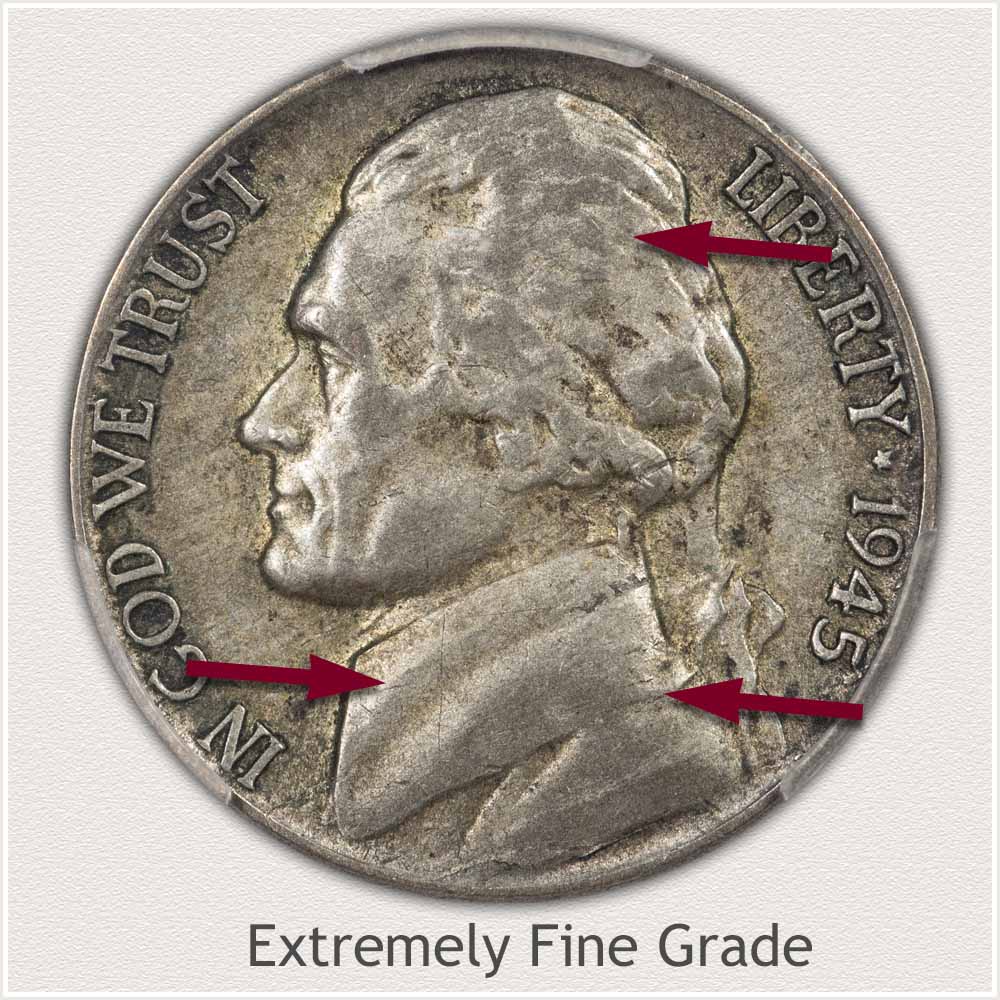
Extremely Fine: Wear in minor amounts, confined to the tops of contours and removal of luster is indicating an Extremely Fine grade nickel.
Viewing the example, notice the bright rotating luster is missing from scattered parts of the design. Jefferson's hair is dull on the high points of the waves in comparison to the lower relief areas.
The collar shows a distinct smooth surface along the higher contours. Removal of luster has left a noticeable dulling of the metal in the area where the coat meets the collar line. A slight merging of coat and collar is seen in the faded detail. Keeping the coin in Extremely Fine grade is none of the points of wear connect, wear is on high points only.
Low Circulated Condition Examples
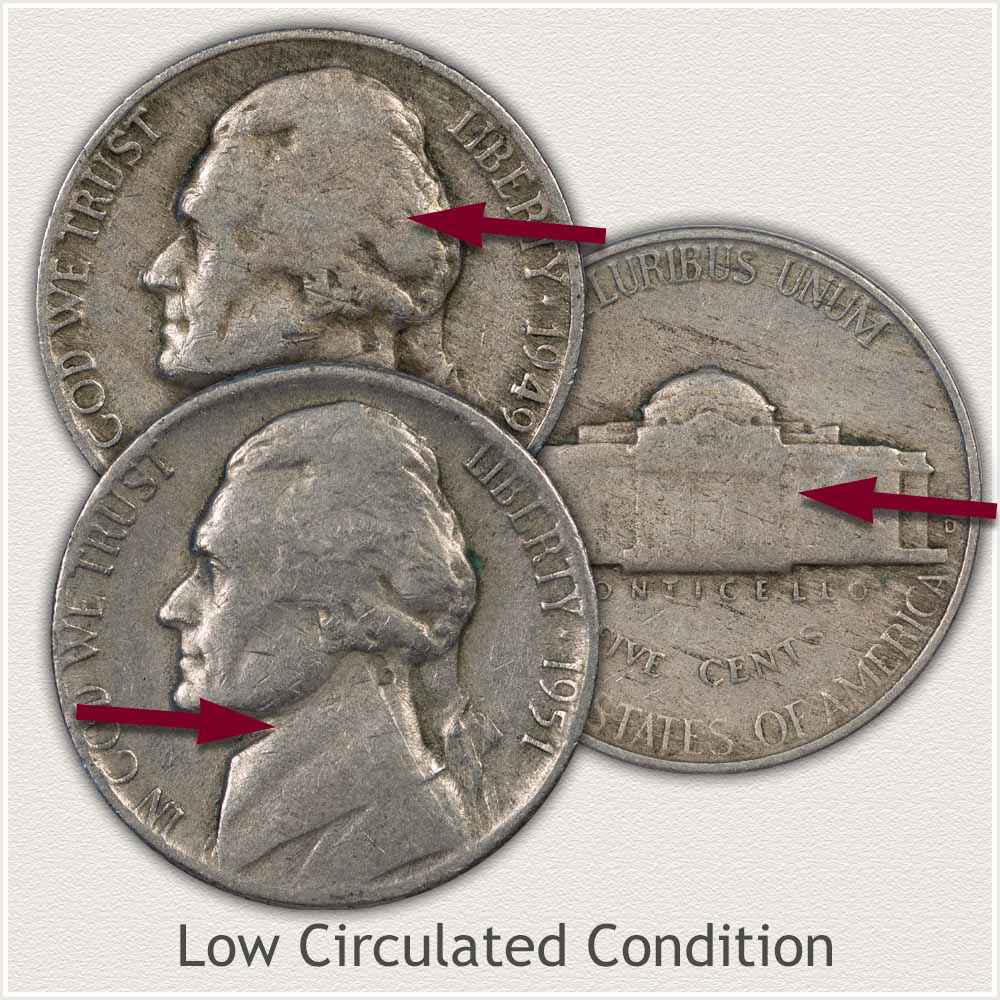
Low Circulated Condition: Noticeable wear and smooth areas covering the surface is a lower condition nickel. Moderate to large amounts of detail are missing. Major details remain, however, are smooth over extended areas.
Jefferson's hair is now a smooth surface, connecting to the forehead and flat from the top of the head to ear. Deep recesses remain in the hair towards the back but fine lines are missing overall.
The collar below the neck is visibly smooth with the high contours leveled. A strong line separating the coat from the collar is missing and one flat surface connects the two.
Inspecting the reverse confirms heavy wear. Monticello is lacking the lines defining the sections of the building, compare to the mint state example. Four columns in the center are just faintly visible, heavy wear is smoothing the fine details and lowering the condition far below the Extremely Fine grade.
How to Video: Grading Jefferson Nickels
Insight into the grades and subtle details of a collectible quality Jefferson nickel.
Video, Images and Descriptions | Grading Jefferson Nickels
Step 3: | Special Qualities Enhancing Value
Strike Completeness Improves Appeal and Demand
As collectors hunt for Jefferson nickels to place into their collection's preservation of the surface of the coin is a major factor. Mint State - no wear - is typically the first choice in grade. The abundant numbers of 1963 nickels in the top grades provides for both many to choose from and affordable prices.
Collectors follow a process of judging quality; beginning with the brilliance and completeness of luster, eye appeal of toning if present, and severity of nicks and marks found on the coin. A subtle quality considered by many is noting the completeness of strike. Jefferson nickels display a very high relief design. Not all produced by the mint were struck with a complete filling of the deepest contours of the design. An incomplete strike has the appearance of "wear" because high contours never filled and remains flat showing the flat surface of the original coin blank.
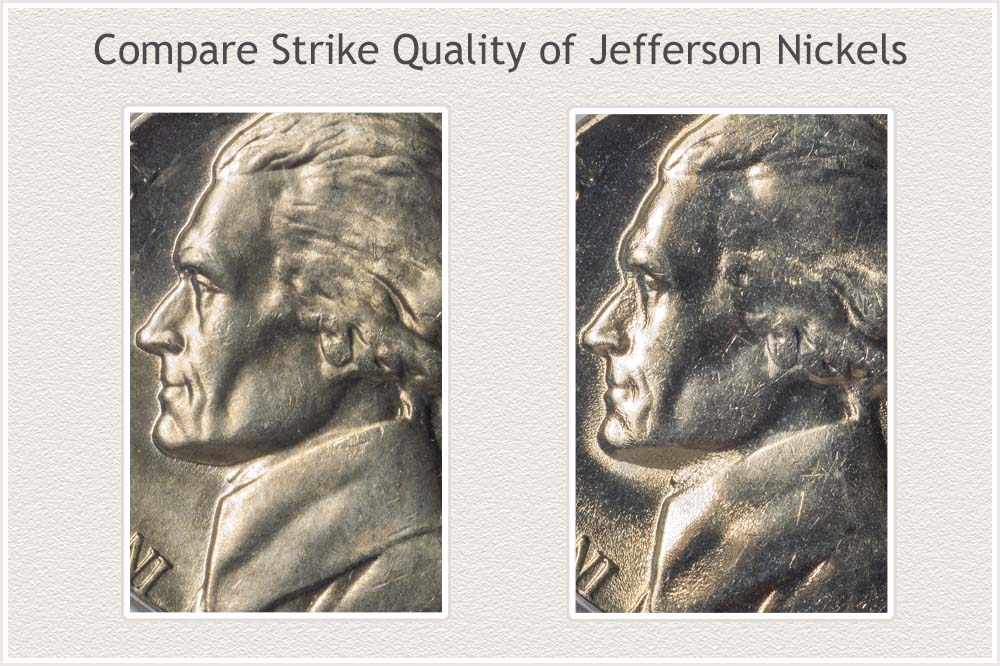
An area helping recognize a complete strike from a lesser quality strike is the tall collar and shoulder of Jefferson's coat. Looking closely at the well struck nickel a fullness and roundness to the contours of the collar are present. Subtle changes in depth are noted on the collar and a very distinct and deep recess separates the coat from collar.
On the coin with a less than complete strike the collar appears flattened, highest areas are not contoured and remain flat because of incomplete metal fill of the die. A noticeable blending of the shoulder and collar is the result of the design lacking the complete line of separation.
A Jefferson nickel in a high state of preservation, bright luster, absence of marks and a compete strike is an eye appealing coin. The extra quality of a complete strike raises the demand of the coin and premium.
References
U.S. Mint. 1964 U.S. Mint Annual Report. https://nnp.wustl.edu/library/book/514149
Coin Values | CoinStudy Articles
Date by Date
In Depth Jefferson Nickel Values
1938 to 1964
Jefferson Nickel Values | Gaining Popularity
Jefferson nickels first minted in 1938 and still minted today are growing in popularity. Collectors focus both on dates from the early eras and condition of the coins when adding to collections. Identify the scarce issues; plus, using grading images, determine collector quality nickels.
Found in the Jefferson series are a few scarce nickels. Earlier nickels, Shield, Liberty, and Buffalo series have a share of valuable examples also. Collectible nickels are sometimes a high condition nickel among a group of coins.
Coin Value Guide | How to Value a Coin Collection
A coin collection is valued using a step-by-step method. Key factors are identified and the coin value guide leads to charts of how much your collection is worth.
Safe Coin Storage | Recommendations
Recommendations on basic supplies that greatly improve coin storage. Providing for safe handling, preserving of value, and organizing your box of old coins.
★ Coin Values Discovery finds 1963 Jefferson Nickel Value and...
All old U.S. coin values. Index listing with images of the different coin series. Match your coins and follow the link to in-depth values. Charts, grading images and a step-by-step procedure uncovers how much your box of old coins is worth.
